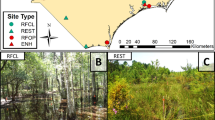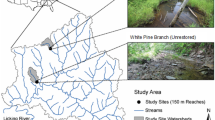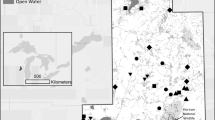Abstract
Pond leveling devices are a cost-effective means to reduce flooding by beavers, while still maintaining water levels in the associated wetland. However, their impacts on biodiversity and ecological function remain unknown, including their effects on aquatic macroinvertebrate assemblages. Macroinvertebrates in these wetland systems are important ecological indicators and play integral roles in ecosystem function through processing of organic matter and supplying energy to higher trophic levels. Immediately before and exactly one year after installing ten pond levelers in east-central Alberta, we sampled their aquatic macroinvertebrate communities among four different habitat types (beaver channel, beaver lodge, open water, vegetated edge). We then compared various measures of their biodiversity (e.g., Shannon index, evenness, species richness, and density) and community composition (e.g., ordination), including among functional feeding groups. Contrary to our hypotheses, we found no differences in all biodiversity measures for aquatic macroinvertebrates pre- and post-installation. Comparing functional feeding groups, omnivores decreased one year post-installation, while shredders increased. Similarly, there was no difference in macroinvertebrate use of within-pond habitats, and water chemistry measures were the same regardless of year. Management actions related to flooding by beavers often result in the regular dewatering of wetlands, with unknown consequences for aquatic biodiversity. Our findings suggest that with the more stable hydrologic environment they create, pond-leveling devices are able to maintain the macroinvertebrate biodiversity that was present prior to installation, thus providing both economic and ecological benefits when managing human-beaver interactions.






Similar content being viewed by others
Data Availability
Not applicable.
Code Availability
Not applicable.
References
Alsfeld AJ, Bowman JL, Deller-Jacobs A (2009) Effects of woody debris, microtopography, and organic matter amendments on the biotic community of constructed depressional wetlands. Biological Conservation 142:247–255. https://doi.org/10.1016/j.biocon.2008.10.017
Anderson NL, Paszkowski CA, Hood GA (2015) Linking aquatic and terrestrial environments: can beaver canals serve as movement corridors for pond-breeding amphibians? Animal Conservation 18:287–294. https://doi.org/10.1111/acv.12170
Ausden M, Sutherland WJ, James R (2001) The effects of flooding lowland wet grassland on soil macroinvertebrate prey of breeding wading birds. Journal of Applied Ecology 38:320–338. https://doi.org/10.1046/j.1365-2664.2001.00600.x
Bergstrom BJ, Arias LC, Davidson AD, Ferguson AW, Randa LA, Sheffield SR (2014) Licence to kill: reforming federal wildlife control to restore biodiversity and ecosystem function. Conservation Letters 7:131–142. https://doi.org/10.1111/conl.12045
Boyles SL, Savitzky BA (2009) An analysis of the efficacy and comparative costs of using flow devices to resolve conflicts with North American beavers along roadways in the coastal plain of Virginia. Proceedings of the 23rd Vertebrate Pest Conference 23:47–52
Bush BM, Wissinger SA (2016) Invertebrates in beaver-created wetlands and ponds. In: Batzer D, Boix D (eds) Invertebrates in Freshwater Wetlands. Springer, Cham, pp 411–449. https://doi.org/10.1007/978-3-319-249778-0_12
Carter JL, Resh VH, Hannaford MJ (2017) Macroinvertebrates as biotic Indicators of environmental quality. In: Lambert GA, Hauer FR (eds) Methods in Stream Ecology, vol 2, 3rd edn. Academic, Cambridge, pp 293–318
Corstanje R, Reddy KR (2004) Response of biogeochemical indicators to a drawdown and subsequent reflood. Journal of Environmental Quality 33:2357–2366. https://doi.org/10.2134/jeq2004.2357
Cummins KW (1973) Trophic relations of aquatic insects. Annual Review of Entomology 18:183–206. https://doi.org/10.1146/annurev.en.18.010173.001151
Daniel J, Polan H, Rooney RC (2021) Determinants of wetland- bird community composition in agricultural marshes of the Northern Prairie and Parkland Region. Wetlands 41:14. https://doi.org/10.1007/s13157-021-01409-6
Davidson NC (2014) How much wetland has the world lost? Long-term and recent trends in global wetland area. Marine and Freshwater Research 65:934–941. https://doi.org/10.1071/MF14173
Downing DJ, Pettapiece WW (2006) Natural regions and subregions of Alberta. Government of Alberta, Edmonton. https://www.albertaparks.ca/media/2942026/nrsrcomplete_may_06.pdf
Dufrêne M, Legendre P (1997) Species assemblages and indicator species: the need for a flexible asymmetrical approach. Ecological Monographs 67:345–366. https://doi.org/10.1890/0012-9615(1997)067[0345:SAAIST]2.0.CO;2
Furse MT, Wright JF, Armitage PD, Moss D (1981) An appraisal of pond-net samples for biological monitoring of lotic macro-invertebrates. Water Research 15:679–689. https://doi.org/10.1016/0043-1354(81)90160-3
Hood GA, Bayley SE (2008) Beaver (Castor canadensis) mitigate the effects of climate on the area of open water in boreal wetlands in western Canada. Biological Conservation 141:556–567. https://doi.org/10.1016/j.biocon.2007.12.003
Hood GA, Larson DG (2014) Beaver-created habitat heterogeneity influences aquatic invertebrate assemblages in boreal Canada. Wetlands 34:19–29. https://doi.org/10.1007/s13157-013-0476-z
Hood GA, Larson DG (2015) Ecological engineering and aquatic connectivity: a new perspective from beaver-modified wetlands. Freshwater Biology 60:198–208. https://doi.org/10.1111/fwb.12487
Hood GA, Manaloor V, Dzioba B (2018a) Mitigating infrastructure loss from beaver flooding: a cost-benefit analysis. Human Dimensions of Wildlife 23:146–159. https://doi.org/10.1080/10871209.2017.1402223
Hood GA, Hvenegaard GT, McIntosh A (2018b) Natural goods and services in a mixed-use landscape. Technical report for Beaver County. University of Alberta, Camrose
Kratzer EB, Batzer DP (2007) Spatial and temporal variation in aquatic macroinvertebrates in the Okefenokee Swamp, Georgia USA. Wetlands 27(1):127–140. https://doi.org/10.1672/0277-5212(2007)27[127:SATVIA]2.0.CO;2
Law A, McLean F, Willby NJ (2016) Habitat engineering by beaver benefits aquatic biodiversity and ecosystem processes in agricultural streams. Freshwater Biology 61(4):486–499. https://doi.org/10.1111/fwb.12721
Legendre P, Gallagher ED (2001) Ecologically meaningful transformations for ordination of species data. Oecologia 129:271–280. https://doi.org/10.1007/s004420100716
Lisle S (2003) The use and potential of flow devices in beaver management. Lutra 46:211–216
Lu K, Wu H, Xue Z, Lu X, Batzer DP (2019) Development of a multi-metric index based on aquatic invertebrates to assess floodplain wetland condition. Hydrobiologia (Incorporating JAQU) 827:141–153. https://doi.org/10.1007/s10750-018-3761-2
McCune B, Grace JB (2002) Analysis of ecological communities. MjM Software Design, Oregon
McManus J, Dickman A, Gaynor D, Smuts B, Macdonald D (2015) Dead or alive? Comparing costs and benefits of lethal and non-lethal human–wildlife conflict mitigation on livestock farms. Oryx 49:687–695. https://doi.org/10.1017/S0030605313001610
Merritt RW, Cummins KW, Berg MB (eds) (2008) An introduction to aquatic insects of North America, 4th edn. Kendall/Hunt Publishing Company, Dubuque
Miller AT, Hanson MA, Church JO, Palik B, Bowe SE, Butler MG (2008) Invertebrate community variation in seasonal forest wetlands: implications for sampling and analyses. Wetlands 28:874–881. https://doi.org/10.1672/07-58.1
Nummi P, Holopainen S (2014) Whole-community facilitation by beaver: ecosystem engineer increases waterbird diversity. Aquatic Conservation 24:623–633. https://doi.org/10.1002/aqc.2437
Nummi P, Lio W, van de Schoor J, Loehr J (2021) Beaver creates early successional hotspots for water beetles. Biodiversity and Conservation 30:2655–2670. https://doi.org/10.1007/s10531-021-02213-8
Pielou EC (1966) The measurement of diversity in different types of biological collections. Journal of Theoretical Biology 13:131–144. https://doi.org/10.1016/0022-5193(66)90013-0
Puttock A, Graham HA, Cunliffe AM, Elliott M, Brazier RE (2017) Eurasian beaver activity increases water storage, attenuates flow and mitigates diffuse pollution from intensively-managed grasslands. Stoten 576:430–443. https://doi.org/10.1016/j.scitotenv.2016.10.122
Puttock A, Graham HA, Ashe J, Luscombe DJ, Brazier RE (2021) Beaver dams attenuate flow: A multi-site study. Hydrol Process 35(2):e14017. https://doi.org/10.1002/hyp.14017
Ray AM, Rebertus AJ, Ray HL (2001) Macrophyte succession Minnesota beaver ponds. Canadian Journal of Botany 79:487–499. https://doi.org/10.1139/b01-18
Reiter DK, Brunson MW, Schmidt RH (1999) Public attitudes toward wildlife damage management and policy. Wildlife Society Bulletin 27:746–758
Romansic JM, Nelson NL, Moffett KB, Piovia-Scott J (2020) Beaver dams are associated with enhanced amphibian diversity via lengthened hydroperiods and increased representation of slow-developing species. Freshwater Biology 66:418–494. https://doi.org/10.1111/fwb.13654
Saari GN, Wang Z, Brooks BW (2018) Revisiting inland hypoxia: diverse exceedances of dissolved oxygen thresholds for freshwater aquatic life. Environmental Science and Pollution Research 25:3139–3150. https://doi.org/10.1007/s11356-017-8908-6
Shannon CE (1948) A mathematical theory of communication. Bell Labs Technical Journal 27:379–423. https://doi.org/10.1002/j.1538-7305.1948.tb01338.x
Taft OW, Colwell MA, Isola CR, Safran RJ (2002) Waterbird responses to experimental drawdown: implications for the multispecies management of wetland mosaics. Journal of Applied Ecology 39:987–1001. https://doi.org/10.1046/j.1365-2664.2002.00763.x
Thompson S, Vehkaoja M, Pellikka J, Nummi P (2020) Ecosystem services provided by beavers Castor spp. Mamm Rev 51:25–39. https://doi.org/10.1111/mam.12220
Treves A, Karanth KU (2003) Human–carnivore conflict and perspectives on carnivore management worldwide. Conservation Biology 17:1491–1499. https://doi.org/10.1111/j.1523-1739.2003.00059.x
Treves A, Krofel M, McManus J (2016) Predator control should not be a shot in the dark. Frontiers in Ecology and the Environment 14:380–388. https://doi.org/10.1002/fee.1312
Turner AM, Trexler JC (1997) Sampling aquatic invertebrates from marshes: evaluating the options. Journal of the North American Benthological Society 16(3):694–709. https://doi.org/10.2307/1468154
Washko S, Roper B, Atwood TB (2020) Beavers alter stream macroinvertebrate communities in north-eastern Utah. Freshwater Biology 65(3):579–591. https://doi.org/10.1111/fwb.13455
Westbrook CJ, Cooper DJ, Baker BW (2006) Beaver dams and overbank floods influence groundwater–surface water interactions of a Rocky Mountain riparian area. Water Resources Research 42(6):1–12. https://doi.org/10.1029/2005WR004560
Willby NJ, Law A, Levanoni O, Foster G, Ecke F (2018) Rewilding wetlands: beavers as agents of within-habitat heterogeneity and the responses of contrasting biota. Philosophical Transactions of the Royal Society B 373:20170444. https://doi.org/10.1098/rstb.2017.0444
Wright JP, Jones CG, Flecker AS (2002) An ecosystem engineer, the beaver, increases species richness at the landscape scale. Oecologia 132:96–101. https://doi.org/10.1007/s00442-002-0929-1
Yarmey NT, Hood GA (2020) Resident perceptions of human-beaver conflict in a rural landscape in Alberta, Canada. Hum-wildl Interact 14(3):476–486
Zhang P, van den Berg RF, van Leeuwen CHA, Blonk BA, Bakker ES (2018) Aquatic omnivores shift their trophic position towards increased plant consumption as plant stoichiometry becomes more similar to their body stoichiometry. PLoS One1 13(9):e0204116. https://doi.org/10.1371/journal.pone.0204116
Zimmerman GM, Goetz H, Mielke PW (1985) Use of an improved statistical method for group comparisons to study effects of prairie fire. Ecology 66:606–611. https://doi.org/10.2307/1940409
Acknowledgements
The authors thank Beaver County for funding this research and Aimee Boese, Bob Beck, and Bernadette Sidoroff for their additional logistical and contract support. We also thank our research assistants Wyatt Beach, Jordan Nakonechny, Emily (Grose) MacLellan, Melissa (Tollitt) Ryan, Tye Dubrule, Shane Hoveland, Kalene Gould, Nick Yarmey, Samara Froland, and Alison Rodvang.
Funding
This research was supported by Beaver County in Alberta, Canada. The authors have no conflicts of interest relative to the research or funding.
Author information
Authors and Affiliations
Contributions
Conceptualization, G.A.H.; field supervision — G.A.H., A.C.S.M. G.T.H.; writing — original draft preparation, G.A.H.; writing analysis, and editing — G.A.H., ACSM, and final manuscript review —G.A.H., ACSM, and GTH. All authors have read and agreed to the published version of the manuscript.
Corresponding author
Ethics declarations
Conflict of Interest
The authors declare no conflict of interest.
Ethics Approval
The University of Alberta’s Animal Care and Use Committee (ACUC) approved this research under protocol AUP00000073.
Consent to Participate
Not applicable.
Consent for Publication
Not applicable.
Additional information
Publisher’s Note
Springer Nature remains neutral with regard to jurisdictional claims in published maps and institutional affiliations.
This article belongs to the Topical Collection: Wetland Conservation.
Rights and permissions
About this article
Cite this article
Hood, G.A., McIntosh, A.C.S. & Hvenegaard, G.T. Ecological Compromise: Can Alternative Beaver Management Maintain Aquatic Macroinvertebrate Biodiversity?. Wetlands 41, 112 (2021). https://doi.org/10.1007/s13157-021-01494-7
Received:
Accepted:
Published:
DOI: https://doi.org/10.1007/s13157-021-01494-7





